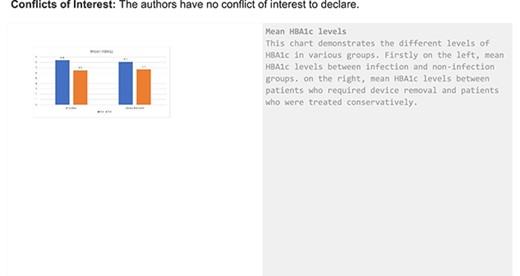-
PDF
- Split View
-
Views
-
Cite
Cite
Dr Abdulrahman Alharbi, Dr Shady Salem, Dr Afnan Awwad, Dr Salman Almuwail, Dr Hamad Almutairi, Dr Faisal Alhajeri, (176) IS HEMOGLOBIN A1C LEVEL A SIGNIFICANT PREDICTOR OF PENILE PROSTHESIS IMPLANTATION INFECTIONS?, The Journal of Sexual Medicine, Volume 21, Issue Supplement_4, May 2024, qdae041.008, https://doi.org/10.1093/jsxmed/qdae041.008
Close - Share Icon Share
Abstract
Diabetes mellitus (DM) is a major risk factor for erectile dysfunction (ED). Penile prothesis implantation is a definitive treatment with good outcomes. However, postoperative infection remains a significant complication. This study investigates the association between Glycated Hemoglobin (HBA1c) levels and penile prosthesis infection rates.
This study is a multi-center retrospective study including all patients underwent penile prothesis implantation between 2015 and 2023. All procedures were performed by the same specialized surgeon. Preoperative, perioperative and postoperative care and prophylaxis were standardized for all patients.
We retrieved and reviewed the records of 62 patients via patients electronic records. Mean age was 54.7±12.4, mean HBA1c was 6.8±1.5. Thirty-nine (62.9%) patients were diabetic. 56 (90.3%) implants were malleable, and 6 (9.6%) were inflatable devices. 11 (17.7%) patients developed penile prosthesis infection, with only 4 (6.4%) treated conservatively, whereas 7 (11.3%) patients required device removal. Patients who had implant infection had a significantly higher mean HbA1c level 8.4±1.9 vs 6.5±1.1 (P=0.002). Although mean HBA1c level was higher among patients who underwent device removal, it was not statistically significant (8.1± 2.2 vs. 6.7±1.3, P=0.093). Moreover, prosthesis infection patients were younger compared to those without prosthesis infection (45.9 ± 13.3 vs. 56.7 ± 11.5 years p=0.0113). DM, peyronie's disease, prosthesis type, operative time and smoking were not significantly associated with infection rate. On multivariate analysis, both higher HBA1c levels and young age were statistically significant predictors for post penile prosthesis infection.
High HBA1c level is associated with increased risk of infection after penile prosthesis implantation.
The authors have no conflict of interest to declare.




